Acoma Polychrome Small Jar with Inwardly Curving Rim by Juana Leno - C4080B
 When I was preparing to open the gallery in Albuquerque Old Town, which opened on 9 September 1978, I was making frequent trips to the New Mexico pueblos to purchase pottery because that was the main feature in those days. Juana Leno was one of my very favorite potters at that time and I visited her and purchased pottery from her on a frequent basis. I don't recall that she ever came into town to sell to me. I always went to Acoma Pueblo to purchase from her. This jar is typical of the very fine work she produced. She was an excellent potter and painter of designs.
When I was preparing to open the gallery in Albuquerque Old Town, which opened on 9 September 1978, I was making frequent trips to the New Mexico pueblos to purchase pottery because that was the main feature in those days. Juana Leno was one of my very favorite potters at that time and I visited her and purchased pottery from her on a frequent basis. I don't recall that she ever came into town to sell to me. I always went to Acoma Pueblo to purchase from her. This jar is typical of the very fine work she produced. She was an excellent potter and painter of designs.
#adobegallery #SouthwestIndianPottery #AcomaPueblo #AcomaPottery #PuebloPottery #SouthwestIndianArt #SantaFePottery #FinePuebloPottery #ContemporaryPottery #JuanaLeno
Award-Winning Acoma Pueblo Tall Thin Necked Jar by Rose Chino - C4080F
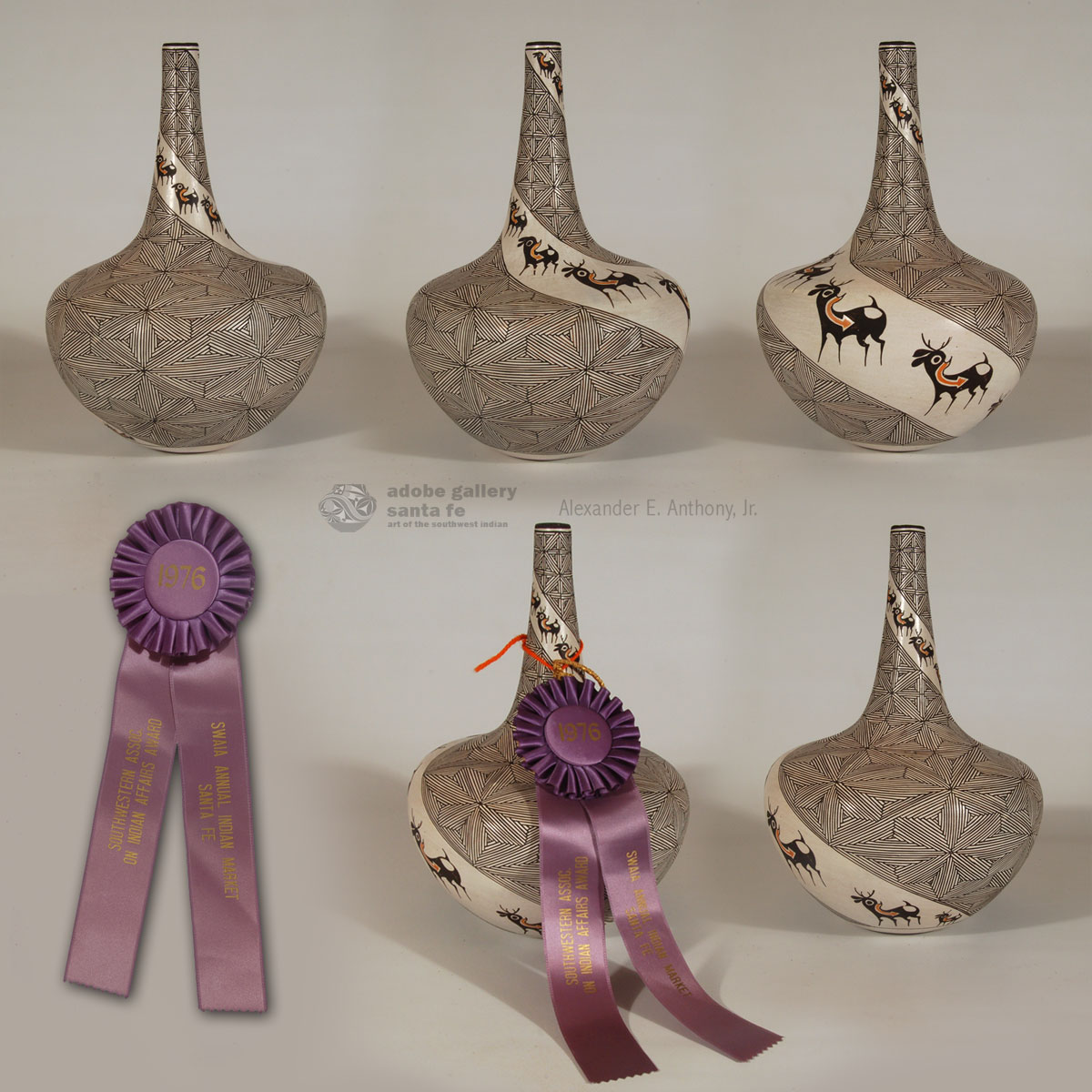 This award-winning jar by Rose Chino was entered in the Santa Fe Indian Market competition in 1976 and was awarded "Most Creative Design in any Classification" by a panel of 16 judges. The award ribbon accompanies the jar.
This award-winning jar by Rose Chino was entered in the Santa Fe Indian Market competition in 1976 and was awarded "Most Creative Design in any Classification" by a panel of 16 judges. The award ribbon accompanies the jar.
Rose was one of the talented daughters of Marie Z. Chino. Among her talented sisters, who also were potters, were Carrie Chino Charlie and Grace Chino. Rose's pottery is in the collections of the Peabody Museum at Harvard University, Heard Museum in Phoenix, Philbrook Museum of Art in Tulsa, and numerous private collections. She has won awards at Santa Fe Indian Market since 1975.
#adobegallery #SouthwestIndianPottery #AcomaPueblo #AcomaPottery #PuebloPottery #SouthwestIndianArt #SantaFePottery #FinePuebloPottery #ContemporaryPottery #RoseChinoGarcia
San Ildefonso Polychrome Nineteenth Century Masterpiece - C4068G
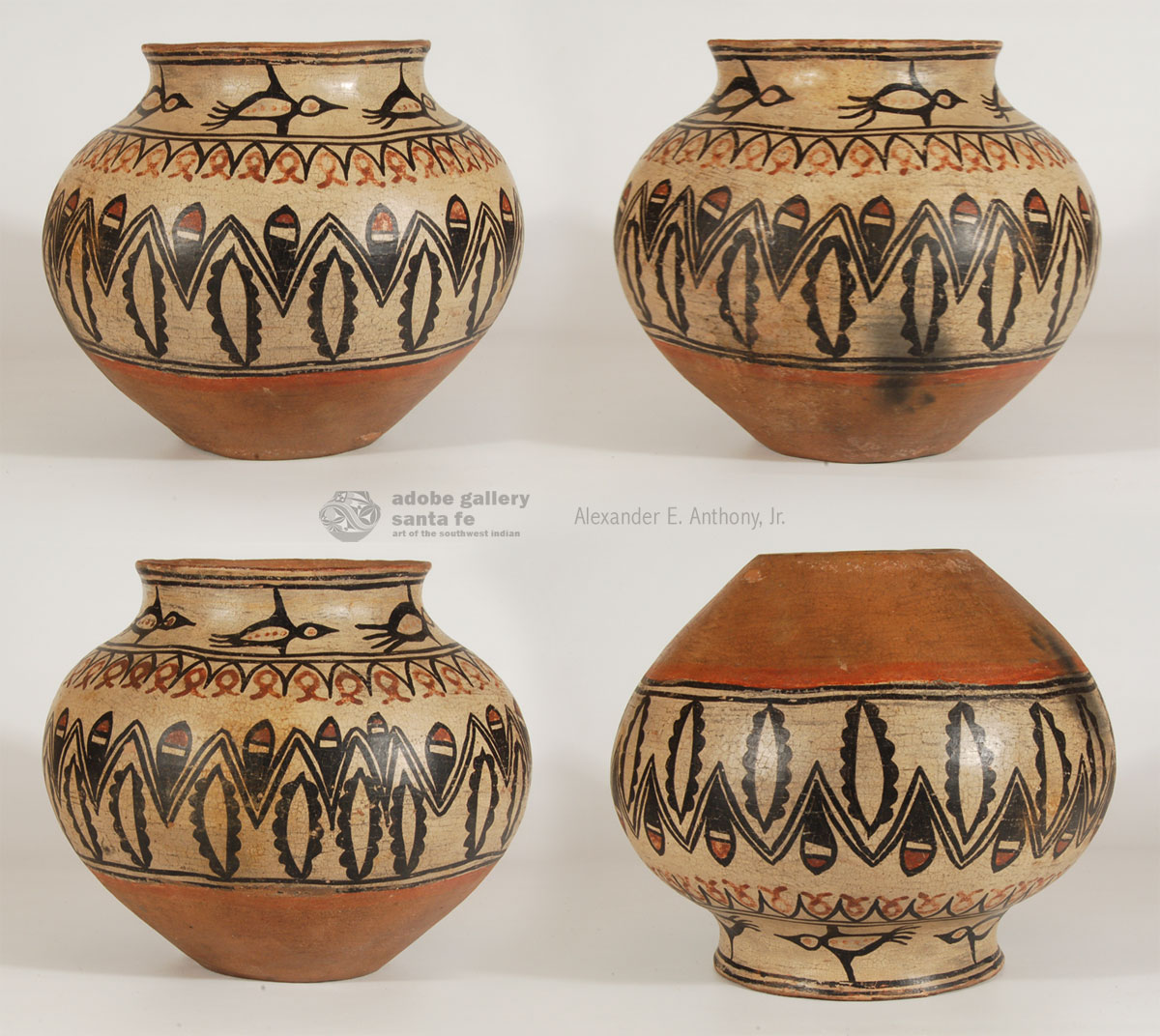 San Ildefonso Polychrome pottery differs from it predecessor pottery typology known as Powhoge Polychrome-one difference being the addition of red in the design. Shapes also changed, as did design elements. The globular shape of Powhoge Polychrome gave way to a revival of the eighteenth-century olla shape.
San Ildefonso Polychrome pottery differs from it predecessor pottery typology known as Powhoge Polychrome-one difference being the addition of red in the design. Shapes also changed, as did design elements. The globular shape of Powhoge Polychrome gave way to a revival of the eighteenth-century olla shape.
In the late 1800s, there was a trend to stop using red paint on the rim and to use black. Around 1905, San Ildefonso Pueblo potters adopted the use of a bentonite slip being used by Cochiti Pueblo potters, the difference being that San Ildefonso traditional slip required stone polishing and Cochiti slip required only rag polishing. All of these factors aid in establishing a date for the older, historic pottery.
This jar has the round and globular shape of a Powhoge Polychrome jar, stone polished slip, and red rim paint. It is conceivable to assign a date of 1880s to this jar.
The extraordinary design must have taken a considerable amount of time for the potter to design and apply. It is by far the most comprehensive design the artist could have conceived. If one starts an analysis on the paired black zigzag lines at the mid-body and proceeds downward, there are oval elements of connected semicircles painted black. Above the zigzag lines there are nestled into each depression single black outlined teardrop designs in red, white and black.
#adobegallery #SouthwestIndianPottery #SanIldefonsoPueblo #SanIldefonsoPottery #PuebloPottery #SouthwestIndianArt #SantaFePottery #FinePuebloPottery #HistoricPottery
Historic Zuni Pueblo Small Heartline Deer and Medallion Jar - C4078N
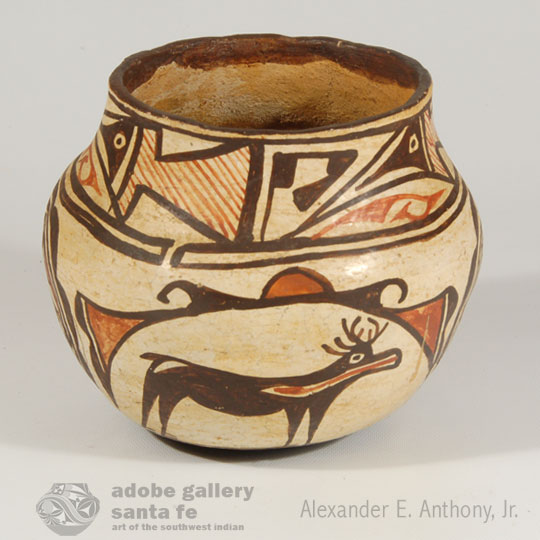 When the Atchison Topeka and Santa Fe train arrived in New Mexico in 1879, it became obvious that the arriving tourists were eager to take back home with them souvenir items from the previously-unknown, to them, Indians of New Mexico. C. G. Wallace, the best-known Indian trader at Zuni Pueblo exerted his influence on the tribal members in what they should make to satisfy this demand for souvenirs.
When the Atchison Topeka and Santa Fe train arrived in New Mexico in 1879, it became obvious that the arriving tourists were eager to take back home with them souvenir items from the previously-unknown, to them, Indians of New Mexico. C. G. Wallace, the best-known Indian trader at Zuni Pueblo exerted his influence on the tribal members in what they should make to satisfy this demand for souvenirs.
Before C. G. Wallace, there had been other traders at Zuni and each had his influence in some way. The first licensed trader was William Wallace who arrived in 1874. The next was Douglas D. Graham who arrived in 1879 and stayed for 20 years, trading manufactured goods for grain, sheep, and wool. His biggest influence over the Zunis was to get them raising cattle which he then traded to distant markets. The third licensed trader was Andrew Vanderwagen, a family name still known today. C. G. Wallace arrived in 1918 and stayed until 1970. His contributions were in stimulating a revival and expansion of jewelry making. His effect on pottery production was the reverse, supposedly because he did not wish to ship pottery.
What had a devastating effect on Zuni pottery was the vast number of expeditions to Zuni, in the late 1800s, collecting thousands and thousands of household items, including pottery. The long-term effect of this was that Zuni potters no longer had classic examples of pottery by which to influence production of new wares. The loss of this library of examples greatly reduced the designs available to consult.
#adobegallery #SouthwestIndianPottery #ZuniPueblo #ZuniPottery #PuebloPottery #SouthwestIndianArt #SantaFePottery #FinePuebloPottery #HistoricPottery
Historic Zuni Pueblo Very Small Pottery Bowl - C4078D
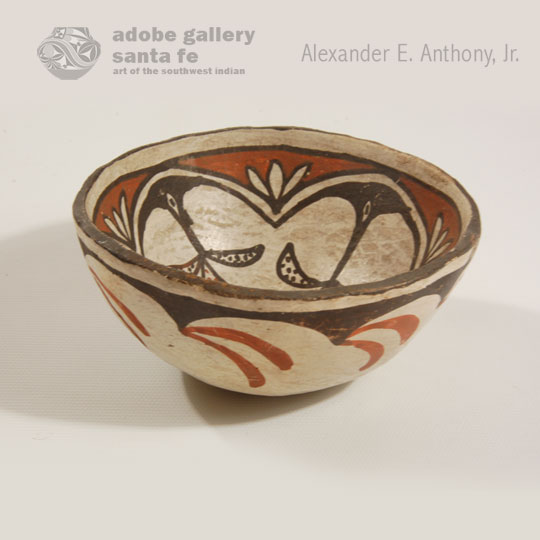 Bowls traditionally have served many functions-individual food consumption, larger food serving bowls, bowls for making bread and bowls for ceremonial functions. Another use for bowls, often overlooked, is as lids for jars. Bowls turned upside down can be stored over the opening of a large jar, serving the functions of storage of the bowl and a lid for a jar. That perhaps explains somewhat why bowls are decorated on the exterior.
Bowls traditionally have served many functions-individual food consumption, larger food serving bowls, bowls for making bread and bowls for ceremonial functions. Another use for bowls, often overlooked, is as lids for jars. Bowls turned upside down can be stored over the opening of a large jar, serving the functions of storage of the bowl and a lid for a jar. That perhaps explains somewhat why bowls are decorated on the exterior.
This small bowl shows no wear patterns so was most likely made as a souvenir item to be sold. It is decorated on the interior and exterior. Most bowls have a black bottom but the white slip on this one covers the entire exterior, including the bottom. The bowl is decorated simply and elegantly with traditional Zuni designs.
#adobegallery #SouthwestIndianPottery #ZuniPueblo #ZuniPottery #PuebloPottery #SouthwestIndianArt #SantaFePottery #FinePuebloPottery #HistoricPottery
Acoma Pueblo Polychrome Jar with Black on White Design - C4078V
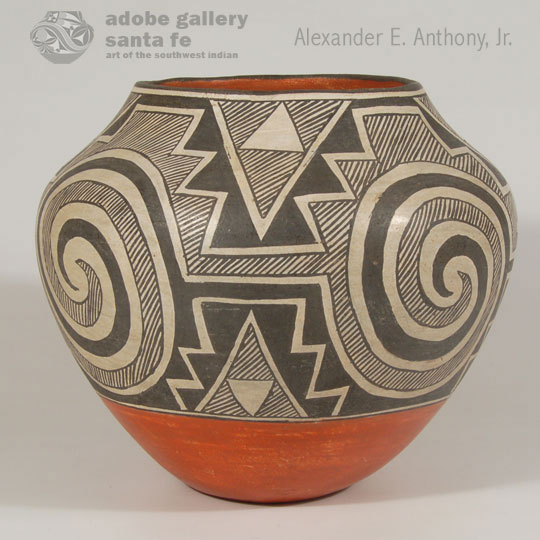 With the arrival of the transcontinental rail line passing through New Mexico, potters at Acoma Pueblo realized a market for pottery that would generate cash for their work. The train stopped at Laguna Pueblo and Acoma potters would take their wares and join the Laguna potters in selling to the train passengers. That is one reason there is confusion concerning whether a jar was from Acoma or Laguna. Little documentation was gathered in the frantic hurry to make a purchase before the train had to continue on its way. A buyer might have made a note that the jar was purchased at Laguna Pueblo, but failed to note whether it was from an Acoma or Laguna potter, a fact of which the buyer may not have even been aware.
With the arrival of the transcontinental rail line passing through New Mexico, potters at Acoma Pueblo realized a market for pottery that would generate cash for their work. The train stopped at Laguna Pueblo and Acoma potters would take their wares and join the Laguna potters in selling to the train passengers. That is one reason there is confusion concerning whether a jar was from Acoma or Laguna. Little documentation was gathered in the frantic hurry to make a purchase before the train had to continue on its way. A buyer might have made a note that the jar was purchased at Laguna Pueblo, but failed to note whether it was from an Acoma or Laguna potter, a fact of which the buyer may not have even been aware.
Although potters were busy making pottery for the daily train passing through, they also continued making magnificent pottery for their own use and for sale to the trader who had a ready market for fine pottery. This jar could have been made either for use at the pueblo or for sale to one of the many traders and museums eagerly looking for fine examples. This one probably dates to around 1940, a time when using designs from prehistoric New Mexico pottery was popular.
#adobegallery #SouthwestIndianPottery #AcomaPueblo #AcomaPottery #PuebloPottery #SouthwestIndianArt #SantaFePottery #FinePuebloPottery #HistoricPottery
Four-Color Acoma Pueblo Jar by Lilly Salvador - C4080G
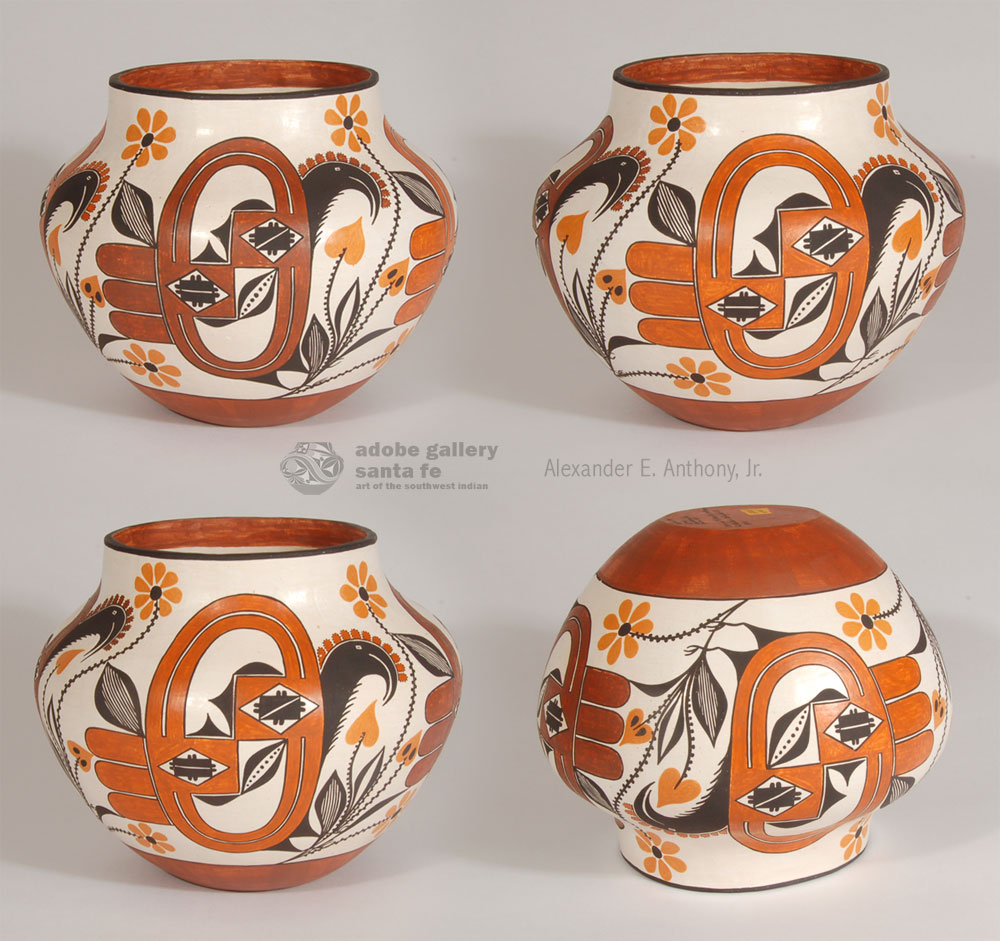 New Mexico Pueblo Indians are proud of the pottery made by their ancestors and have brought some of the early designs back to life by recreating those designs on new vessels. That is what this jar represents. Lilly M. Salvador has recreated designs from an historic Acoma jar that is in the Smithsonian which she states dates to circa 1800.
New Mexico Pueblo Indians are proud of the pottery made by their ancestors and have brought some of the early designs back to life by recreating those designs on new vessels. That is what this jar represents. Lilly M. Salvador has recreated designs from an historic Acoma jar that is in the Smithsonian which she states dates to circa 1800.
In her recreation of the Smithsonian's historic jar, Lilly Salvador provides us with a look at what must be an amazing 19th century vessel. Each of the four birds is unique in presentation from contemporary Acoma birds, which are generally more realistic parrot representations. The birds on this jar have a wonderful body-oval in shape, dual wide bands, and horizontal black elements within. The black heads of the birds resemble those of parrots, yet differ in style. The head feathers are orange with black dots outlining their edges. Two of the birds are presented in orange color and two in a darker rust color. Between each bird is a floral plant that is in bloom. The rim is black and the underbody is in traditional Acoma deep red. The bottom is flat.
#adobegallery #SouthwestIndianPottery #AcomaPueblo #AcomaPottery #PuebloPottery #SouthwestIndianArt #SantaFePottery #FinePuebloPottery #ContemporaryPottery #LillySalvador
Historic Ohkay Owingeh (San Juan) Pueblo Small Serving Bowl - C4078B
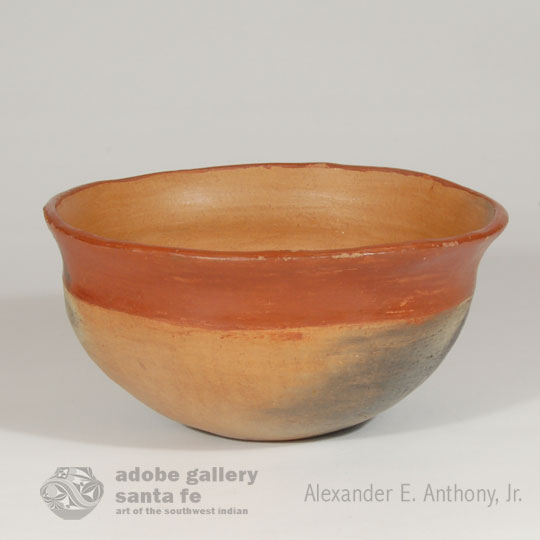 Ohkay Owingeh Pueblo, formerly known as San Juan Pueblo, has a significant history in relation to New Mexico. In 1598 the new Spanish settlement near this pueblo was made the first capital of the New Mexico province of New Spain by Juan de Oñate. It is 25 miles north of Santa Fe, which replaced it as the capital when founded in 1608.
Ohkay Owingeh Pueblo, formerly known as San Juan Pueblo, has a significant history in relation to New Mexico. In 1598 the new Spanish settlement near this pueblo was made the first capital of the New Mexico province of New Spain by Juan de Oñate. It is 25 miles north of Santa Fe, which replaced it as the capital when founded in 1608.
San Juan Pueblo was the northern terminus of the Camino Real de Tierra Adentro, an important historic trail from Mexico City used by settlers and traders from 1598 to 1884. San Juan Pueblo was also the home of Popé, the leader of the Pueblo Revolt of 1680 against the Spanish. In 2005, San Juan Pueblo went back to its pre-Spanish name Ohkay Owingeh.
This bowl is of the pre-revival style that was traditional to the pueblo before the 1935 style change. The bowl was stone-polished on the interior and exterior. Red slip was applied to the exterior of the rim. The underbody of the vessel was then allowed to receive fire clouds during the firing process-the only decoration of such pottery. This bowl is likely from the first quarter of the 20th century.
#adobegallery #SouthwestIndianPottery #OhkayOwingehPueblo #OhkayOwingehPottery #PuebloPottery #SouthwestIndianArt #SantaFePottery #FinePuebloPottery #HistoricPottery
Santa Clara Pueblo Black carved Bowl by Pablita Chavarria - C4080A
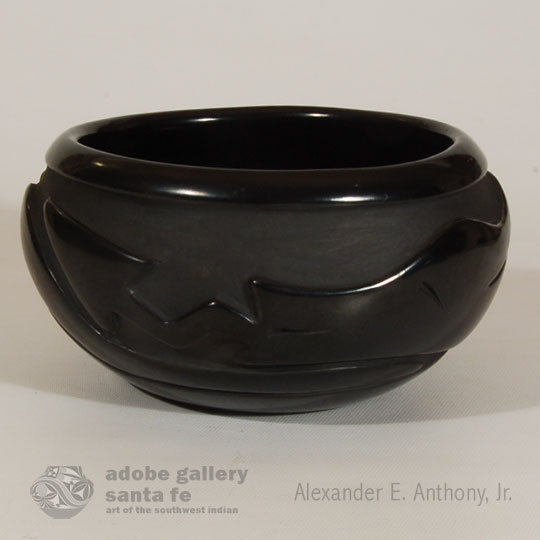 Pablita Tafoya Chavarria was born in 1914 at Santa Clara Pueblo. She started making carved blackware, black-on-black jars, bowls, vases, wedding vases, plates, and miniatures in 1930. Her favorite designs were Avanyu, hummingbirds, flowers, and clouds. She passed away in 1979.
Pablita Tafoya Chavarria was born in 1914 at Santa Clara Pueblo. She started making carved blackware, black-on-black jars, bowls, vases, wedding vases, plates, and miniatures in 1930. Her favorite designs were Avanyu, hummingbirds, flowers, and clouds. She passed away in 1979.
Pablita married Jose M. Chavarria and they had eleven children: Clara Shije, Reycita Naranjo, Thomas Chavarria, Elizabeth Naranjo, Florence Browning, Mary Singer, Mary Agnes Carlisle, Loretto Chavarria, Joe M. Chavarria, Mildred Chavarria, and José N. Chavarria. Clara, Reycita, Elizabeth, Florence, and Mary were active potters through the end of the twentieth century and into the twenty-first.
#adobegallery #SouthwestIndianPottery #SantaClaraPueblo #SantaClaraPottery #PuebloPottery #SouthwestIndianArt #SantaFePottery #FinePuebloPottery #ContemporaryPottery #PablitaChavarria
Navajo Painting of Four Horses Ascending by Ha So De - C4059.25
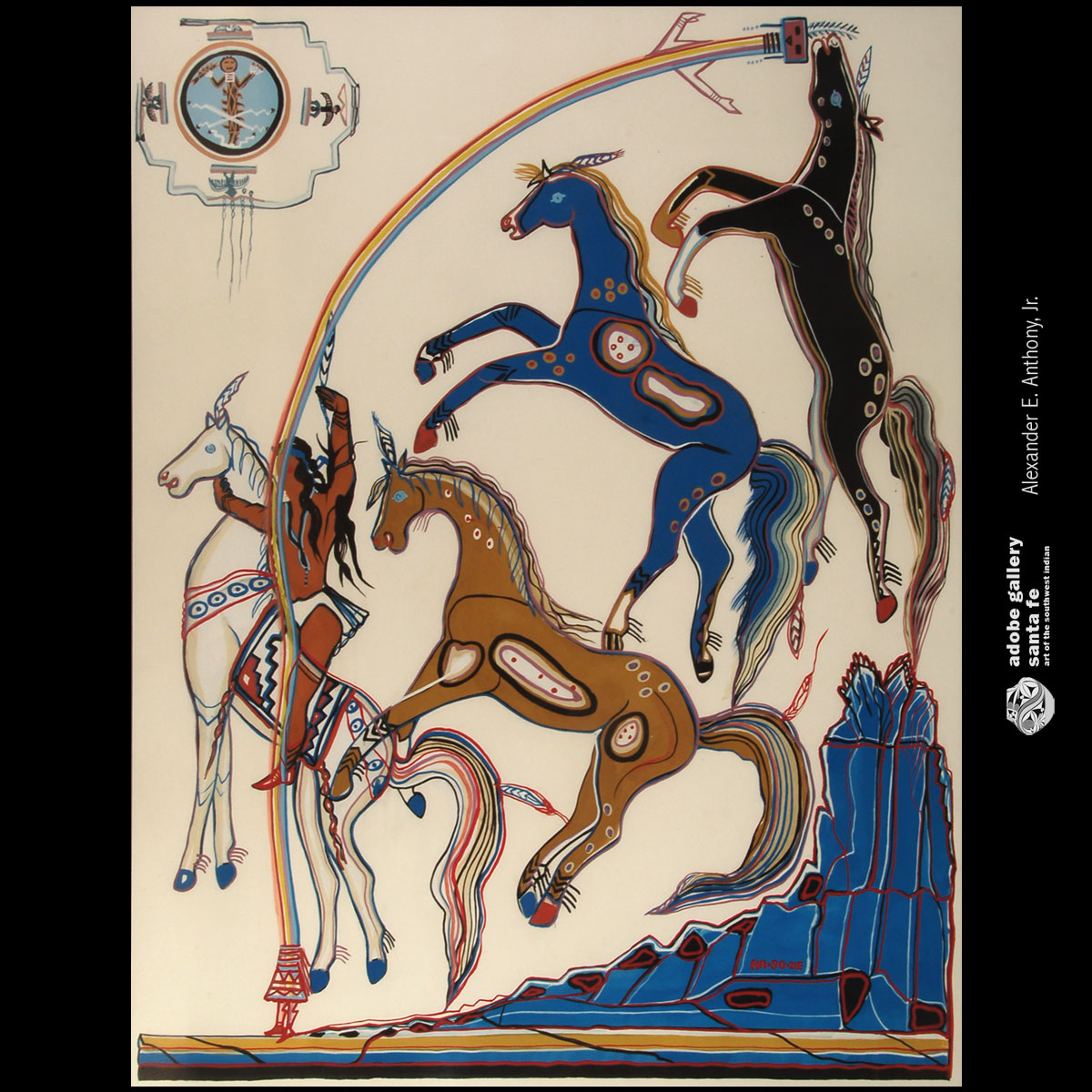 Narciso Platero Abeyta (1918-1998) Ha So De was a Navajo painter and silversmith. He was also, among other things, a Golden Gloves boxer and one of the hundreds of Navajo Code Talkers who served in the Marines during World War II. He and wife Sylvia Ann had seven children, many of whom-Tony Abeyta, Elizabeth Abeyta Rohrscheib and Pablita Abeyta-became notable artists themselves. He is highly revered by collectors of Native American paintings, and his works are included in numerous prestigious public and private collections.
Narciso Platero Abeyta (1918-1998) Ha So De was a Navajo painter and silversmith. He was also, among other things, a Golden Gloves boxer and one of the hundreds of Navajo Code Talkers who served in the Marines during World War II. He and wife Sylvia Ann had seven children, many of whom-Tony Abeyta, Elizabeth Abeyta Rohrscheib and Pablita Abeyta-became notable artists themselves. He is highly revered by collectors of Native American paintings, and his works are included in numerous prestigious public and private collections.
Abeyta received his initial art education at the Santa Fe Indian School, whose art instructor Dorothy Dunn commented on his abilities in her book American Indian Painting of the Southwest and Plains Areas: "Ha-So-De developed a markedly unique style, although, in his formative period, his admiration for the work of (Navajo painter Andy) Tsihnahjinnie could be clearly seen. It was a fine influence and used honorably by the younger painter. His paintings of hunt and home scenes were broad in brushwork and flowing in line, at times appearing almost nonchalant. He was never concerned with small detail but only with the sweep and dash of movement in wild, free scenes. His was a positive art." He received further education at the University of New Mexico, where he studied under famous modernist painter Raymond Jonson.
#adobegallery #SouthwestIndianPainting #NativeAmericanPainting #FineArt #Painting #Navajo #Diné #SantaFeNM #FinePuebloPainting #HaSoDe #NarcisoAbeyta
San Ildefonso Pueblo Black on Black Plate signed Marie - C4079
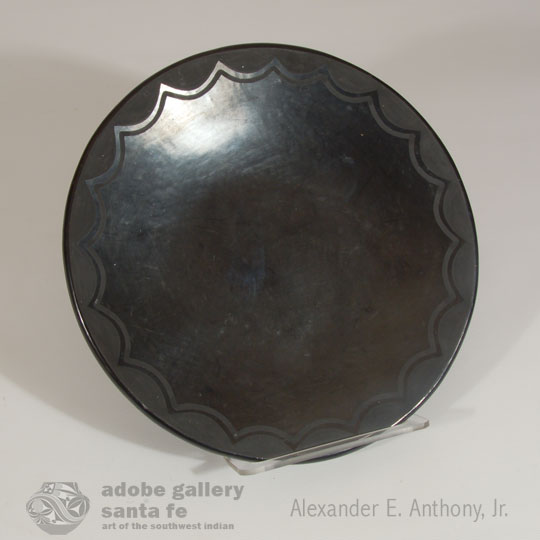 Maria Martinez used a variety of signatures during her long career. The first signature on black pottery was Marie-a signature used when she made the item and Julian painted the design. His name was omitted in the early years because pottery was considered "woman's work." It was only after they were convinced that his painting did not constitute doing "woman's work," but was the work of an artist, that his name was confidently added alongside Maria's. The Marie signature was used between 1923 and 1925. Spivey 2003 This pottery plate is signed into the clay with the name Marie. It is accepted then that Maria made the plate and Julian painted it between 1923 and 1925.
Maria Martinez used a variety of signatures during her long career. The first signature on black pottery was Marie-a signature used when she made the item and Julian painted the design. His name was omitted in the early years because pottery was considered "woman's work." It was only after they were convinced that his painting did not constitute doing "woman's work," but was the work of an artist, that his name was confidently added alongside Maria's. The Marie signature was used between 1923 and 1925. Spivey 2003 This pottery plate is signed into the clay with the name Marie. It is accepted then that Maria made the plate and Julian painted it between 1923 and 1925.
#adobegallery #SouthwestIndianPottery #SanIldefonsoPueblo #SanIldefonsoPottery #PuebloPottery #SouthwestIndianArt #SantaFePottery #FinePuebloPottery #ContemporaryPottery #MarieMartinez
Acoma Pueblo Bowl with Pie Crust Rim by Lupe Paytiamo - C3925Z
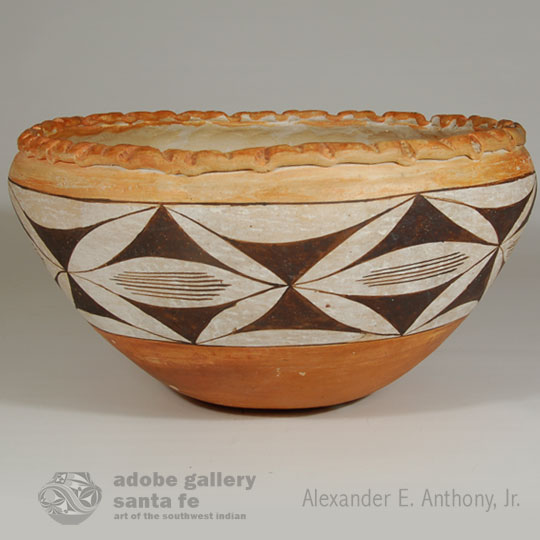 This bowl by Lupe Paytiamo has a very attractive design on the exterior with kite-looking black shapes floating around the sky. Parallel black lines fill the centers of the design elements. The interior of the bowl was left in the natural state, not polished. A rather sloppy white slip was either dripped or painted near the interior rim, almost as if a child got hold of the paint brush. The exterior view of the bowl is quite attractive and is the view that should be enjoyed.
This bowl by Lupe Paytiamo has a very attractive design on the exterior with kite-looking black shapes floating around the sky. Parallel black lines fill the centers of the design elements. The interior of the bowl was left in the natural state, not polished. A rather sloppy white slip was either dripped or painted near the interior rim, almost as if a child got hold of the paint brush. The exterior view of the bowl is quite attractive and is the view that should be enjoyed.
Written in pencil on the base is "July 8, '61 Made in Acoma Lupe Paytiamo."
#adobegallery #SouthwestIndianPottery #AcomaPueblo #AcomaPottery #PuebloPottery #SouthwestIndianArt #SantaFePottery #FinePuebloPottery #ContemporaryPottery #LupePaytiamo
Very Small Historic Polychrome Zia Pueblo Storage Jar - C3925E
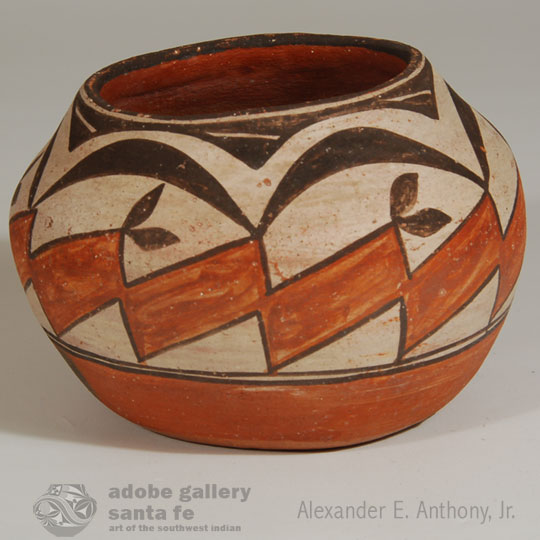 This very small Zia Pueblo storage jar could possibly be from the early 20th century. It is in the shape of a storage jar, but in miniature scale. The main body design consists of tilted and connected red domino-like rectangles, outlined in black, with some having paired ovals attached to a corner. Above those elements are black arches. The base is concave, whereas a true storage jar would have a flat bottom. The rim is painted black and there is a pair of framing lines below the design area. A wide matte red band was wiped on under the framing lines and almost covers the entire red area below the design.
This very small Zia Pueblo storage jar could possibly be from the early 20th century. It is in the shape of a storage jar, but in miniature scale. The main body design consists of tilted and connected red domino-like rectangles, outlined in black, with some having paired ovals attached to a corner. Above those elements are black arches. The base is concave, whereas a true storage jar would have a flat bottom. The rim is painted black and there is a pair of framing lines below the design area. A wide matte red band was wiped on under the framing lines and almost covers the entire red area below the design.
![]()
#adobegallery #SouthwestIndianPottery #ZiaPueblo #ZiaPottery #PuebloPottery #SouthwestIndianArt #SantaFePottery #FinePuebloPottery #HistoricPottery
Historic Zia Pueblo Small Jar with Traditional Zia Bird Design - C3925F
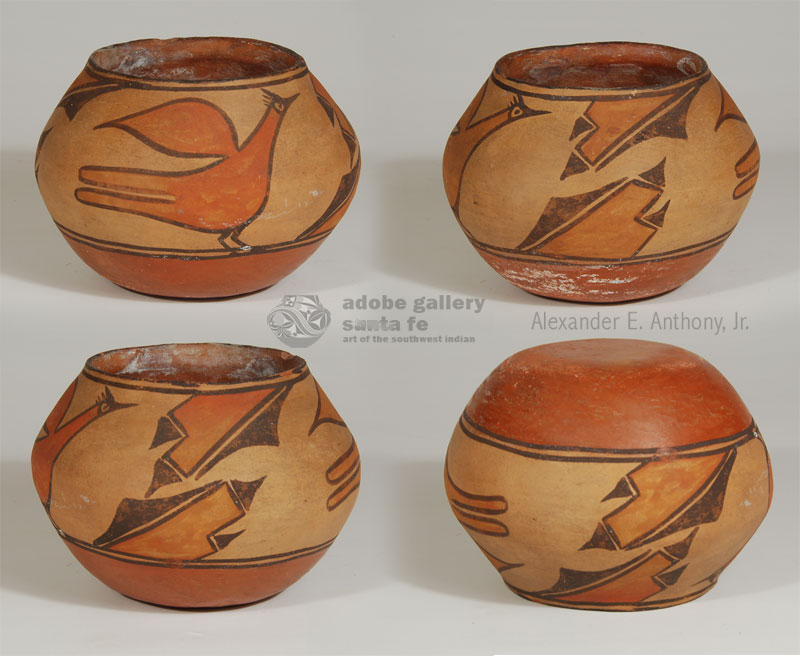 This small Zia Pueblo jar is a four-color example-cream, black, red and orange. One bird is red and the other one is orange, both outlined in black and both resting on the lower framing line. The tipped feathers also alternate between red and orange. The background color has turned a soft cream/yellow from decades of age.
This small Zia Pueblo jar is a four-color example-cream, black, red and orange. One bird is red and the other one is orange, both outlined in black and both resting on the lower framing line. The tipped feathers also alternate between red and orange. The background color has turned a soft cream/yellow from decades of age.
#adobegallery #SouthwestIndianPottery #ZiaPueblo #ZiaPottery #PuebloPottery #SouthwestIndianArt #SantaFePottery #FinePuebloPottery #HistoricPottery
Historic Laguna Pueblo Handled Bowl with Printed Text - C4078C
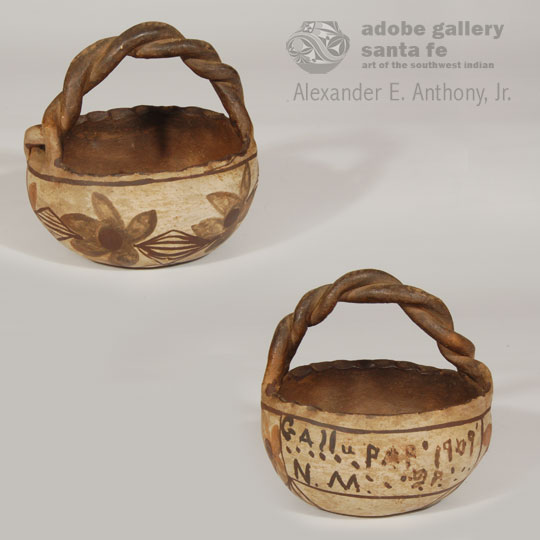 What happened in Gallup, New Mexico, on April 28, 1909? Apparently it was an important enough event to cause a Laguna Pueblo potter to memorialize that date on this pottery bowl. It is possible that it was a tragic event involving a Laguna Pueblo member or family. Perhaps, too, it was a joyful event that involved a Laguna member. Let's hope it was the latter.
What happened in Gallup, New Mexico, on April 28, 1909? Apparently it was an important enough event to cause a Laguna Pueblo potter to memorialize that date on this pottery bowl. It is possible that it was a tragic event involving a Laguna Pueblo member or family. Perhaps, too, it was a joyful event that involved a Laguna member. Let's hope it was the latter.
This bowl is a good example to explain where so many similar twisted-handle bowls at Isleta Pueblo had their beginnings. This type bowl was typical at Laguna Pueblo. When members of Laguna Pueblo migrated to Isleta Pueblo in 1879 they took with them their pottery styles and designs which were then adopted by Isleta potters and eventually replaced what was then traditional Isleta pottery style. The Laguna polychrome pottery style then became what we know today as the Isleta polychrome style.
This bowl, however, is from Laguna and not from Isleta. It was made with Laguna clay and has the traditional Laguna chain-like line of flowers. It is a four-color bowl with that deep red color seen at Acoma and Laguna in the late 1800s and very early 1900s.
#adobegallery #SouthwestIndianPottery #LagunaPueblo #LagunaPottery #PuebloPottery #SouthwestIndianArt #SantaFePottery #FinePuebloPottery #HistoricPottery
Original Navajo Painting “One with the Wind” by Hush Ka Yel Ha Yah - C4077A
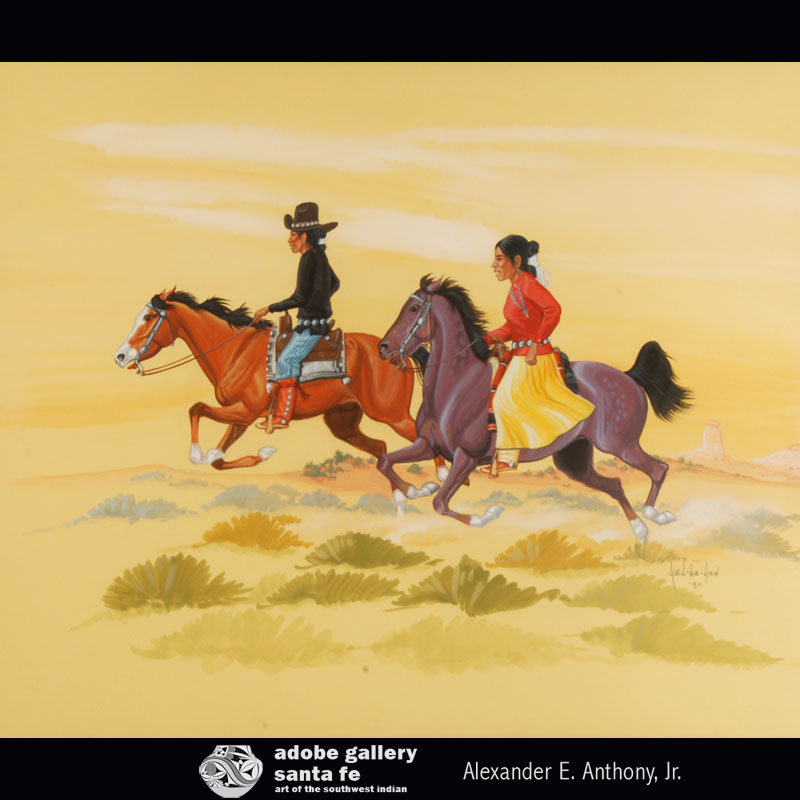 Charlie Lee (1926-2003) Hush Ka Yel Ha Yah (Warrior Who Came Out) was a Navajo painter who was educated by Geronima Montoya at the Santa Fe Indian School. During his high school years, he met Navajo artist Harrison Begay. Lee claimed to have unsuccessfully attempted to create works in Begay's style. Nevertheless, he wound up creating many works that were obviously influenced by Begay. After completing high school, he returned to the Navajo reservation and then back to Santa Fe, as he "did not feel at home at all" on the reservation. He continued studying music and art, and was ultimately moved to become a missionary. He attended Springfield, Missouri's Central Bible Institute and then returned to the Navajo Nation.
Charlie Lee (1926-2003) Hush Ka Yel Ha Yah (Warrior Who Came Out) was a Navajo painter who was educated by Geronima Montoya at the Santa Fe Indian School. During his high school years, he met Navajo artist Harrison Begay. Lee claimed to have unsuccessfully attempted to create works in Begay's style. Nevertheless, he wound up creating many works that were obviously influenced by Begay. After completing high school, he returned to the Navajo reservation and then back to Santa Fe, as he "did not feel at home at all" on the reservation. He continued studying music and art, and was ultimately moved to become a missionary. He attended Springfield, Missouri's Central Bible Institute and then returned to the Navajo Nation.
Like many Navajo painters, Lee's most commonly depicted subjects are horses and everyday rituals. Clara Lee Tanner's Southwest Indian Painting: A Changing Artdescribes Lee as a "good example of an Indian who started painting in the Navajo traditional style and then developed an occasional flourish in the direction of more realism. His late-1960s paintings demonstrated more ability and versatility than are to be noted in his earlier efforts." Tanner goes on to list his accomplishments: "Yel-Ha-Yah has exhibited extensively in the Southwest. He has won various prizes, including two firsts at the New Mexico State Fair in Albuquerque in 1947. Later recognition of his better work includes a Scottsdale second award in 1963 and a third prize at the 1969 Gallup Show." Lee passed away in 2003.
#adobegallery #SouthwestIndianPainting #NativeAmericanPainting #FineArt #Painting #Navajo #Diné #SantaFeNM #FinePuebloPainting #CharlesLee
Buffalo Dancer - Indians Forever Suite by Fritz Scholder - C3984J
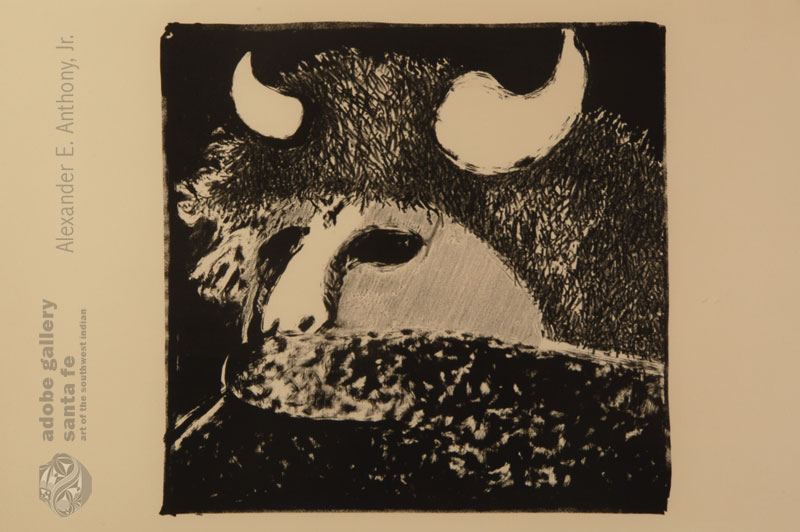 Fritz Scholder, a painter and printmaker who was one-quarter Luiseño, vowed early in his career never to "paint the Indian." Scholder eventually became interested in Native art and culture-particularly that of the New Mexico Pueblo Indians-when he moved to Santa Fe to teach at the newly-established Institute of American Indian Arts. Scholder was inspired by the ideas presented to him by his young Native students, and ultimately decided that he himself needed to tackle the subject. He painted his first Indian during the winter of 1967, and would go on to create hundreds of images of Indians. They were fresh, beautiful, and occasionally controversial. They have become some of his most iconic images.
Fritz Scholder, a painter and printmaker who was one-quarter Luiseño, vowed early in his career never to "paint the Indian." Scholder eventually became interested in Native art and culture-particularly that of the New Mexico Pueblo Indians-when he moved to Santa Fe to teach at the newly-established Institute of American Indian Arts. Scholder was inspired by the ideas presented to him by his young Native students, and ultimately decided that he himself needed to tackle the subject. He painted his first Indian during the winter of 1967, and would go on to create hundreds of images of Indians. They were fresh, beautiful, and occasionally controversial. They have become some of his most iconic images.
In 1970, Scholder signed a contract to create a series of lithographs at Albuquerque's Tamarind Institute. He had experimented with lithography in college, and described the process as "laborious and terribly technical." Under the guidance of Tamarind's experienced printers, however, Scholder began to enjoy the lithography process. Scholder was invigorated by what was, to him, a new way to create and present his ideas. His first major project at Tamarind was his "Indians Forever" suite, which was presented in a portfolio containing eight of his best early pieces.
#adobegallery #SouthwestIndianPainting #NativeAmericanPainting #Luiseño #PuebloPaintings #SantaFeNM #FineArt #Print #FritzScholder
Dancers at Zuni Stone Lithograph by Fritz Scholder - C3984B
 Fritz Scholder (1937-2005) was born in Breckenridge, Minnesota. He was one-quarter Luiseño, a tribe from Southern California. It was apparent early on that he was a very talented artist. His high school teacher was famous Yankton Dakota artist, Oscar Howe, who recognized and encouraged his talent. In 1955, he attended the Mid-West Art and Music Camp at the University of Kansas where he was voted "Best Boy Artist" and President of Art Camp.
Fritz Scholder (1937-2005) was born in Breckenridge, Minnesota. He was one-quarter Luiseño, a tribe from Southern California. It was apparent early on that he was a very talented artist. His high school teacher was famous Yankton Dakota artist, Oscar Howe, who recognized and encouraged his talent. In 1955, he attended the Mid-West Art and Music Camp at the University of Kansas where he was voted "Best Boy Artist" and President of Art Camp.
After high school Scholder went on to study with artists Greg Kondos, Lloyd Kiva New, Charles Loloma and Wayne Thiebaud among others. In 1964, after receiving his MFA at University of Arizona, Scholder accepted the position of instructor in Advanced Painting and Contemporary Art History at the newly-formed Institute of American Indian Arts in Santa Fe, New Mexico.
In 1970, Tamarind Institute moved from Los Angeles to Albuquerque. Scholder was invited by Tamarind to do the first major project, a suite of lithographs, Indians Forever. It was the beginning of a large body of work in that medium for the artist. Scholder/Indians was published by Northland Press, the first book on Scholder's work.
#adobegallery #SouthwestIndianPainting #NativeAmericanPainting #Luiseño #PuebloPaintings #SantaFeNM #FineArt #Print #FritzScholder
Lithograph Indian at the Lake by Fritz Scholder - C3984U
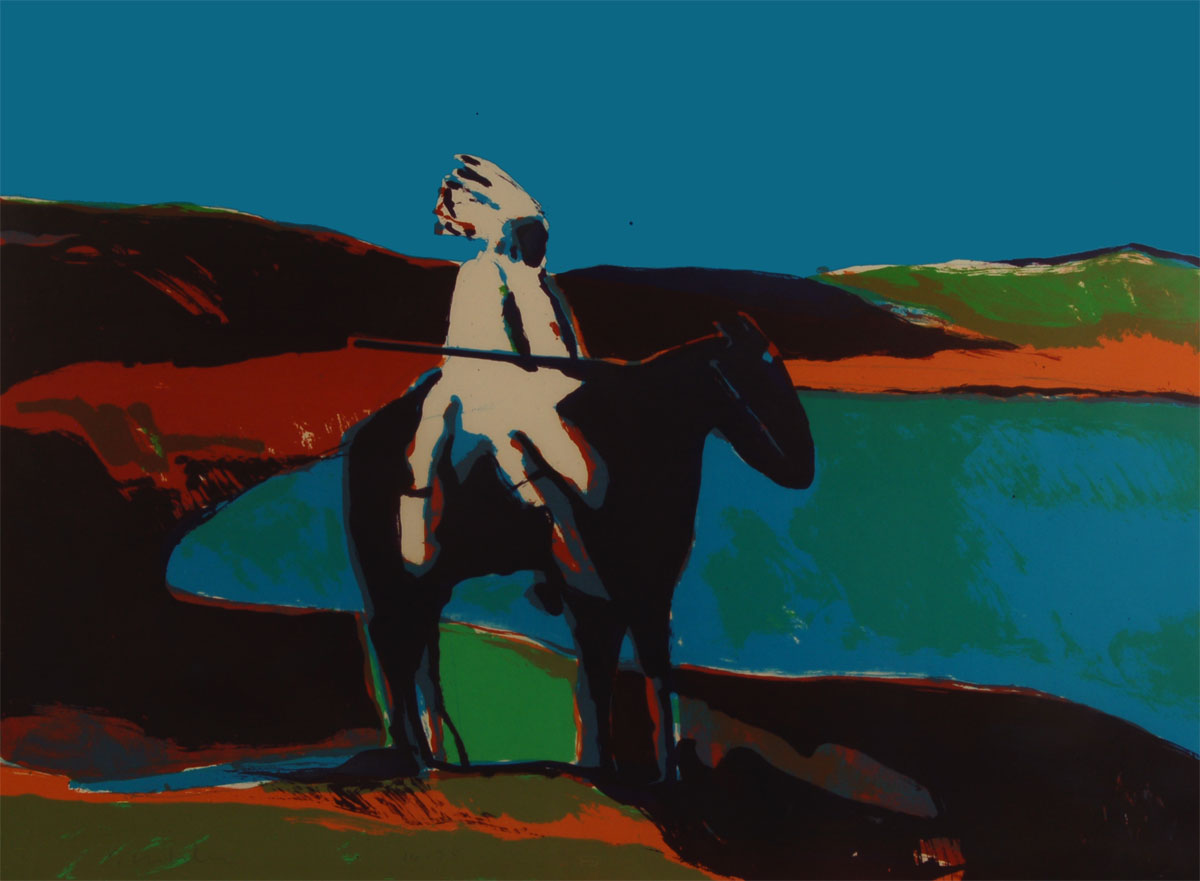 Fritz Scholder (1937-2005) was a world-renowned painter, printmaker and sculptor of Luiseño descent. Trained as an abstract painter, he had little interest in the representational paintings of ceremonial functions that were being made and sold by Native artists. Anglo-American artists' portrayals of Indian subjects were, in his opinion, a "tremendous visual cliché." Scholder, who at one point had vowed never to create works with Native themes or subject matter, would become one of the most famous and influential figures in the world of Native American art.
Fritz Scholder (1937-2005) was a world-renowned painter, printmaker and sculptor of Luiseño descent. Trained as an abstract painter, he had little interest in the representational paintings of ceremonial functions that were being made and sold by Native artists. Anglo-American artists' portrayals of Indian subjects were, in his opinion, a "tremendous visual cliché." Scholder, who at one point had vowed never to create works with Native themes or subject matter, would become one of the most famous and influential figures in the world of Native American art.
In 1964, Scholder moved to Santa Fe to teach painting at the newly-established Institute of American Indian Arts. He was surrounded by Native art, and began adding pieces to his personal collection. He began attending ceremonial functions at the neighboring Pueblos. Most importantly, he was inspired by the artworks being created by his young Native students. In 1967, he began creating images of Indians in his own singular style.
In 1969, Scholder signed a contract with Albuquerque's Tamarind Institute to create a portfolio of similarly-themed lithographs. His compositional talents and unique eye for color were well-suited to the unique medium. Even his earliest attempts at Tamarind were artistic successes. His Indians Forever suite, completed in 1971, contained depictions of Indians that ranged from nearly traditional to radically innovative.
#adobegallery #SouthwestIndianPainting #NativeAmericanPainting #Luiseño #PuebloPaintings #SantaFeNM #FineArt #Print #FritzScholder

